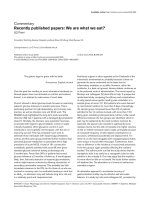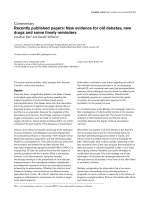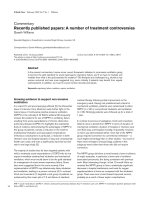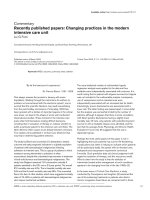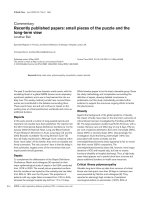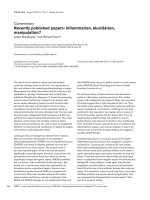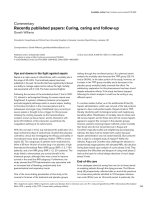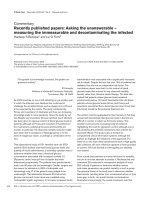Báo cáo y học: " Recently published papers: Topical issues in pharmacology" pptx
Bạn đang xem bản rút gọn của tài liệu. Xem và tải ngay bản đầy đủ của tài liệu tại đây (32.49 KB, 2 trang )
ICU = intensive care unit; RCT = randomized controlled trial; VF = ventricular fibrillation.
Critical Care June 2002 Vol 6 No 3 Williams and Ball
The use of pharmacological agents in intensive care units
(ICUs) is ever on the increase, with novel therapies appearing
in the literature regularly. The complexities of polypharmacy
are a challenge to the intensivist, and any guidance as to
which drugs to use, when to use them and how much to use
is always welcome. Happily, therefore, over the past
2 months a number of interesting papers and articles have
appeared covering drugs both new and old.
Cardiac arrest in the community is associated with a very
high mortality rate. Ventricular fibrillation (VF) is both the most
common mode of arrest and carries the best prognosis if
early defibrillation is available [1]. However, a subgroup of
patients with VF are resistant to direct current defibrillation, in
which case an antiarrythmic agent is required, but very few
randomized controlled trials (RCTs) have been conducted to
verify the efficacy of any particular agent.
Dorian and colleagues [2] compared lidocaine with
amiodarone in the management of out-of-hospital, shock-
resistant VF. In a double-blind RCT, 347 patients were
randomly assigned to either lidocaine 1.5 mg/kg or
amiodarone 5 mg/kg as an initial dose. In addition, a further
1.5 and 2.5 mg/kg, respectively, were given if required. The
primary end-point was survival to hospital. A total of 41
patients (22.8%) in the amiodarone group and 20 patients
(12.0%) in the lidocaine group survived to hospital
(P = 0.009; odds ratio 2.17, 95% confidence interval
1.21–3.83). However, only nine patients in the amiodarone
and five in the lidocaine group survived to hospital discharge.
In this population, receiving amiodarone increased the
chances of an individual arriving at hospital alive. Time to
paramedic intervention (i.e. drug administration), however,
was an equally important factor. Interestingly, time interval to
first attempted defibrillation was not associated with a
survival benefit, which is presumably a reflection of the
refractory nature of the VF. Sadly, the survival rate to
discharge – a more relevant outcome – between the groups
was not significantly different, with overall survival to
discharge being a dismal 4%. This low survival is consistent
with out-of-hospital cardiac arrest. However, it seems
reasonable to extrapolate these findings to the in-patient
population, in which case administration of amiodarone as
the first-line agent for shock-resistant VF may result in
improved survival in the hospital setting.
Staying with matters cardiac, an RCT that considered the
management of acute exacerbations of chronic heart failure
was published in March 2002 in the Journal of the American
Medical Association [3]. The precise role of the selective
phosphodiesterase inhibitor milrinone in intensive care
remains obscure, with no survival benefit demonstrated.
Acute exacerbation of chronic heart failure is a relatively
common indication for admission into a critical care setting,
but with few randomized outcome trials to guide our
management. This study investigated whether a short course
of milrinone could improve clinical outcomes. Patients were
randomly assigned to a 48-hour infusion of milrinone
(0.5 µg/kg per min initially) or placebo. The number of
hospital days for management of cardiovascular problems 60
days after randomization did not differ between the two
groups, and no difference was found for in-hospital or 60-day
mortality. The milrinone group suffered higher incidences of
hypotension requiring intervention and new atrial arrhythmias.
The study adds weight to the feeling that the selective
phosphodiesterase inhibitors contribute little to the general
intensivists pharmacological arsenal.
Singer and colleagues [4] reported on eight patients with
septic shock refractory to fluid, catecholamine, corticosteroid
and methylene blue therapy who were salvaged with the
long-acting vasopressin analogue terlipressin. The use of
vasopressin has previously been described in resistant
Commentary
Recently published papers: Topical issues in pharmacology
Gareth Williams
1
and Jonathan Ball
2
1
Clinical Fellow in Intensive Care Medicine, St. George’s Hospital, Blackshaw Road, Tooting, London, UK
2
Lecturer in Intensive Care Medicine, St. George’s Hospital, Blackshaw Road, Tooting, London, UK
Correspondence: Gareth Williams,
Published online: 9 May 2002 Critical Care 2002, 6:196-197
© 2002 BioMed Central Ltd (Print ISSN 1364-8535; Online ISSN 1466-609X)
Available online />hypotension secondary to sepsis, but is associated with
troublesome rebound hypotension on withdrawal [5,6]. An
intravenous bolus of terlipressin (1–2 mg) was given to each
of eight patients demonstrating profound and resistant
vascular hyporeactivity. Bolus terlipressin resulted in a
progressive increase in mean arterial pressure, allowing
withdrawal of noradrenaline (norepinephrine) in seven of the
eight patients. This improvement in mean arterial pressure was
maintained for 5 hours; one patient required a repeat bolus.
Four patients went on to ICU discharge and three to hospital
discharge. No negative sequelae were noted. The authors
concluded that, although the mechanism of increased
vasomotor sensitivity to terlipressin is not known, it offers a
promising alternative for management of life-threatening and
intractable hypotension in septic shock. Although such
reports are somewhat anecdotal, the results are promising for
a condition that is known to carry a high mortality rate, and it
may be that the time for a larger outcome trial approaches.
The March/April edition of Intensive Care Monitor [7]
comments on a paper that examined the immunomodulatory
effects of high-dose hydrocortisone in septic shock [8]. It is
known that cortisol has permissive and suppressive effects
on the immune response, and it has been reported that
supraphysiological doses can reverse septic shock [9].
However, little is known regarding the cytokine response to
high-dose hydrocortisone. In a small, double-blind, placebo-
controlled RCT, 24 patients with septic shock were randomly
assigned to either high-dose hydrocortisone or placebo [8].
End-points included time to shock reversal and effect on
serum cytokine concentration. By day 3 the Sequential
Organ Failure Assessment score was lower in the
hydrocortisone group than in the placebo group (P < 0.05).
No difference in mortality was found. Interleukin-6 and
interleukin-8 were both significantly reduced in the treatment
group, whereas interleukin-10 and tumour necrosis factor-α
were similar between the two groups.
The observed reduction in interleukin-6 levels is of
significance because this proinflammatory cytokine has been
correlated with severity of septic shock, and this may explain
the quicker resolution of organ-related morbidity in the
treatment group. This is consistent with findings reported in a
more recent paper on the effects of methylprednisolone in
unresolving acute respiratory distress syndrome [10], and
may account for a therapeutic modality by which high-dose
steroid therapy works. It is difficult to conclude a great deal
more from this study, but it positively contributes towards a
rationale for the use of steroids in management of the
inflammatory response.
Thromboembolic disease is a frequent cause of morbidity
and mortality in ICU patients, and it often goes undetected.
Low-molecular-weight heparins have been shown to reduce
significantly the incidence of thromboembolic complications
[11] and are now considered standard therapy, but the
incidence remains high in critically ill patients when
compared with that in other patient populations. A group
from Amsterdam postulated in The Lancet that this may be
partly due to lowered bioavailability resulting from
vasopressor use in critically ill patients. They considered
three groups of patients: ICU patients on vasopressors, ICU
patients not on vasopressors and postoperative ward
patients. Each patient had received at least three doses of
nadroparin 2850 IU. Serial concentrations of factor Xa
activity (do the authors mean anti-factor Xa activity?) were
compared between the groups. The biological action of the
low-molecular-weight heparin was found to be significantly
less in ICU patients on vasopressors than in ICU patients not
on vasopressors and in postoperative ward patients.
This lower heparin activity may contribute to the observed
high incidence of thromboembolism in the critically ill
population. It is suggested that vasopressor therapy reduces
the uptake of subcutaneously administered drug as a result
of impaired peripheral perfusion, and therefore these patients
should be given greater doses. In the absence of routine anti-
factor Xa activity assays, some caution may be required
before instituting blind dose increases for a group of patients
who are at risk of occult bleeding and for a drug with effects
that are difficult to reverse.
Competing interests
None declared.
References
1. Eisenberg MS, Mengert TJ: Cardiac resuscitation. N Engl J Med
2001, 344:1304-1313.
2. Dorian P, Cass D, Schwartz B, Cooper R, Gelaznikas R, Barr A:
Amiodarone as compared with lidocaine for shock-resistant
ventricular fibrillation. N Engl J Med 2002, 346:884-890.
3. Cuffe MS, Califf RM, Adams KF Jr, Benza R, Bourge R, Colucci
WS, Massie BM, O’Connor CM, Pina I, Quigg R, Silver MA, Ghe-
orghiade M: Short-term intravenous milrinone for acute exac-
erbation of chronic heart failure: a randomized controlled trial.
JAMA 2002, 287:1541-1547.
4. O’Brien A, Clapp L, Singer M: Terlipressin for norepinephrine-
resistant septic shock. Lancet 2002, 359:1209-1210.
5. Malay MB, Ashton RC Jr, Landry DW, Townsend RN: Low-dose
vasopressin in the treatment of vasodilatory septic shock. J
Trauma 1999, 47:699-703.
6. Tsuneyoshi I, Yamada H, Kakihana Y, Nakamura M, Nakano Y,
Boyle WA III: Hemodynamic and metabolic effects of low-dose
vasopressin infusions in vasodilatory septic shock. Crit Care
Med 2001, 29:487-493.
7. Jenkins IR: Immunomodulation in septic shock: hydrocorti-
sone differentially regulates cytokine response. Intensive Care
Monitor 2002, 9:32-33.
8. Briegel J, Jochum M, Gippner-Steppert C, Thiel M: Immunomod-
ulation in septic shock: hydrocortisone differentially regulates
cytokine responses. J Am Soc Nephrol 2001, 12(suppl 17):
S70-S74.
9. Bollaert PE, Charpentier C, Levy B, Debouverie M, Audibert G,
Larcan A: Reversal of late septic shock with supraphysiologic
doses of hydrocortisone. Crit Care Med 1998, 26:645-650.
10. Umberto Meduri G, Tolley AE, Chrousos GP, Stentz F: Prolonged
methylprednisolone treatment suppresses systemic inflam-
mation in patients with unresolving acute respiratory distress
syndrome. Am J Respir Crit Care Med 2002, 165:983-991.
11. Attia J, Ray JG, Cook DJ, Douketis J, Ginsberg JS, Geerts WH:
Deep vein thrombosis and its prevention in critically ill adults.
Arch Intern Med 2001, 161:1268-1279.

